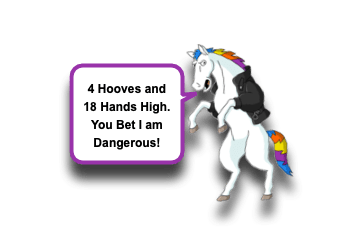Horse Related Injuries in Children

Horse Related Injuries: Basics
Even though you may not be a “horse person,” asking what the breed of the horse involved was and what activity was (ex, steeplechase, trail riding, etc) can help you determine the mechanism.
- The breed may affect the physics.
- Hands High
- Horses are traditionally measured in “Hands” – One hand = 4 inches.
- The height of the horse is measured from the ground to the top of the withers (the bony prominence above the shoulders and at the base of the neck, near where the rider sits), not the top of the head.
- A 5 foot (60 inch) horse would be 15 Hands High (60in divided by 4 inches = 15 hh).
- Fun confusion – interesting trivia to know for “game night:”
- Decimals are not fractions when discussing hands high.
- 15.1 = 15 hands, 1 inch
- 15.2 = 15 hands, 2 inches (or 15 and a half hands)
- 15.3 = 15 hands, 3 inches
- 15.4 = 15 hands, 4 inches… which is 16 hh
- 15.5 does not exist.
- The average height of the horse is dependent upon the breed. [Reference.com]
- American Quarter Horse average height – 15 hh
- Draft horse average height – 18 hh (6 feet tall)
- Horses are traditionally measured in “Hands” – One hand = 4 inches.
- Weight
- Once again, this depends on the breed.
- Some adult horses may be as “light” as 750-900 lbs (ex, Appaloosa), while others can be from 1,000 – 2,000 lbs.
- Speed
- The breed also affects the speed and agility of the animal.
- A Quarter horse can get up to 50 mph.
- The gait (walk, trot, canter, gallop) of the horse also influences the speed (just like you can walk, jog, run, or sprint).
- Hands High
- Their kick packs a punch!
- A horse can kick backwards, forwards, and sideways.
- Horses have been known to kick through 3/4 inch plywood.
- Few studies actually define the kick force power a horse can exert, but one found a horse kick can generate over 8,000 Newtons of force.
- The mechanics matter too!
- Obviously falling off while trail riding from a calm and serene horse is different then being flung from a rowdy and rambunctious mustang during a steeplechase. Physics just matter.
- The former may be considered similar to toppling off of a ladder.
- The latter is more akin to losing control of a motorcycle and being launched over a small building.
- Cross-Country riding (which involves speed and jumps) has been associated with greatest percentage of injuries (~40%). [Bixby-Hammett, 1985]
- Jumping also associated with high percentage of injuries (~22%). [Bixby-Hammett, 1985]
- Being near a horse is hazardous too!
- Non-riding activities like grooming, feeding, handling, shoeing, and saddling can still place a young child in harms way of an unpredictable horse.
- 15-17% of injuries in one study were due to kicks. [Zoetsch, 2013; Barone, 1989]
- Injuries to non-riders account for ~27% of horse related injuries. [Lang, 2014]
- Non-riders frequently sustain injuries that require surgery. [Lang, 2014]
- Obviously falling off while trail riding from a calm and serene horse is different then being flung from a rowdy and rambunctious mustang during a steeplechase. Physics just matter.
Horse Related Injuries in Children
- Of farm related injuries, ~37.5% due to horses. [Smith, 2004]
- Over 2 million children engage in Equestrian sports. [McCrory, 2005; Bixby-Hammett, 1985]
- Inexperienced riders are ~5 times more likely to be seriously injured. [Cuenca, 2009]
- Unfortunately, accidents occur and injuries can be significant. [Lang, 2014; Zoetsch, 2013; Cuenca, 2009; Smith, 2004; Barone, 1989; Bixby-Hammett, 1985]
- Head Injuries and Maxillofacial Trauma are the most common injuries.
- Orthopedic Injuries are the second most common set of injuries.
- Abdominal Injury
- Chest Trauma
- Pulmonary Contusion
- Pneumothorax
- One case of Traumatic injury to the Tricuspid Heart Valve from a kick to the chest that ruptured the chordae. [Loar, 2016]
- Polytrauma
- For those that sustain an injury that requires evaluation in the ED, many will require hospitalization: more than 50% in one study. [Cuenca, 2009]
- 18% required surgery
- 27% required ICU level care
- Average length of stay was 3.7 days.
Horse Related Injuries: Injury Prevention
- Helmets are often underutilized and lack of helmet use is associated with more serious injuries. [Short, 2017; Cuenca, 2009]
- Since facial and head injuries can occur even when not riding the horse (ex, kick to the face), some advocate for children wearing helmets with facial shields any time they are near horses. [Lang, 2014]
- Novice riders and young children should be closely supervised when working around horses in the barns, fields, and show areas. [AAP, 1992; Barone, 1989]
- Some advocate for protective vests, although clear evidence of their advantage is lacking. [Hessler, 2012]
Moral of the Morsel
- Physics matters and Force = Mass x Acceleration. Horses have a lot of mass and can accelerate quickly! They may not mean to cause harm, but sometimes that doesn’t matter.
- Details matter. Determine whether this was more like a 2,000 lb motorcycle becoming airborne or a slip off a 5 foot ladder.
- Also take the time to educate. “Well, we can fix the broken arm… but now let’s talk about wearing that helmet!”

